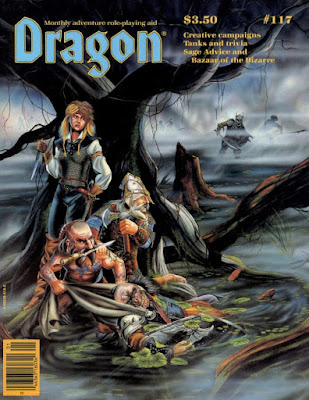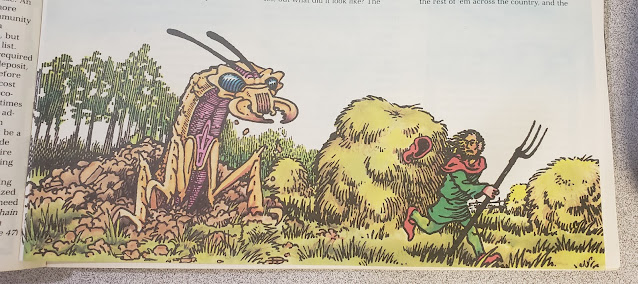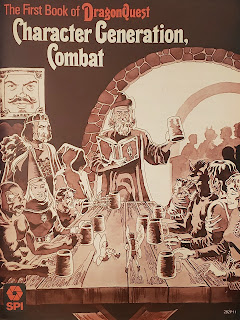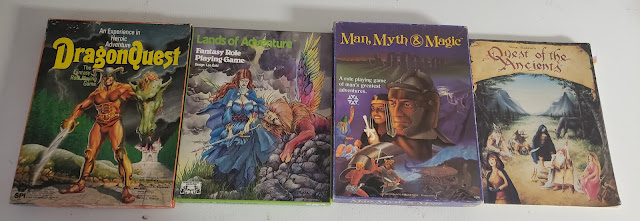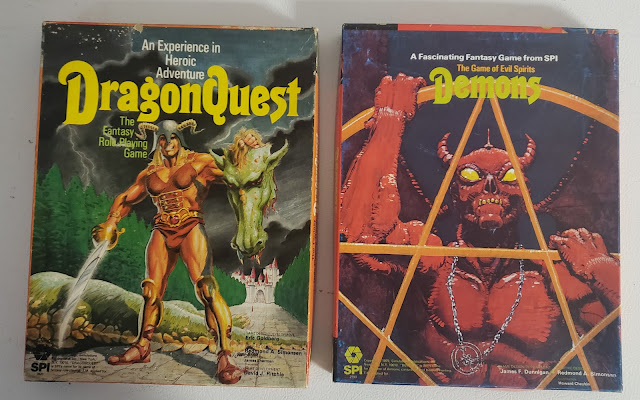This issue, #117, comes to us from January 1987. At least that is what the issue says on the front page, the page footer tells us this is January 1986. Oops! It is 1987 though. I am in my Senior year at High School getting ready to go off to the University. I have no idea yet, but life is gonna change for me in wonderful ways. But that is still to come. It is January 1987. The number #1 song on the radio is "Everybody Have Fun Tonight" by Wang Chung. In the theatres, the #1 movie is Eddie Murphy in "The Golden Child" and on the shelves and game tables around the world is #117 of This Old Dragon!
The cover is one from Jim Halloway, one of my favorites of his.
It is 1987 and things feel different at Dragon. For starters, Kim Mohan has now been gone since November and Roger Moore is now the EiC at Dragon (and I think Dungeon as well). You can feel the change in terms of letters, profiles, and even the new games. I'll get to these all in turn. I attributed this back then to the rise of prominence of the Forgotten Realms, but that was just an outward manifestation of what was happening. In less than a year Gygax, Mentzer, and Mohan had all left TSR. The current "Sage in Residence" would fall to Ed Greenwood.
Letters covers the items bothering gamers of the time. We have one wanting the Cthulhu and Melniboné mythos back. Sorry dude. Another wants more DragonQuest material now that TSR owns it. Also sorry dude. We are given a nice list of Dragon issues that have DragonQuest material: #49, 57, 78, 82, 86, 89, 92, 96, and 97. So we at least have that.
Big ad for Hawkmoon. While I did not play the game I was HUGE in the Eternal Champion then and would finally get my hands on the Hawkmoon books at college.
People in the Forum are STILL debating over the "mostly nude" cover from Dragon #114.
Ad for the Science Fiction Book Club. Show of hands, how many of my readers got books from them? I can count at least 4 or 5 I had bought from this ad, or one like it, back in the day.
Our first article is The Elements of Mystery from Robert Plamondon. An interesting short article about adding the thrill of the unknown back to your game.
Ah, the math geek in me is very happy to see this article from Arthur J. Hedge III. What are the Odds covers the probabilities of the Unearthed Arcana's Method V of rolling up characters. I love that he proudly tells us that the tables were generated on a DEC VAX computer using a program written in C! You can do the same now on any computer that can run a spreadsheet program. Or even in Google Sheets. The tables are great and he introduces a new terminology in dice rolling. So Method V for humans allowed you pick your class first and then roll up to 9d6s in your prime attribute to find your score. Hedge's notation would have this at 9d6s3 or "Roll 9 six-sided dice and choose the best three rolls". For what is considered standard in many games then is 4d6s3. I kinda wish it had caught on. BTW in the 9d6 here are 10,077,696 combinations with an "18" resulting from 1,796,446 of them for a P=0.17825960.
Feuds and Feudalism comes to us from John-David Dorman. It is a short article on, well, basically reminding everyone that Feudalism is a thing in AD&D.
Travis Corcoran streamlines the tables for AD&D combat on the heels of Unearthed Arcana in Condensed Combat. If you are playing AD&D and really love the weapons vs. AC matrix then I highly recommend finding a copy of this. My issue here is not the chart or how it was intended to be used, I think the intent was right. It was with how it was used in every day play. While the AC is a nice shorthand, the table would have been better served by putting the Armor type down. So instead of "AC 5" on the chart is should say "Chain Mail." The author DOES make an effort to help clear this up and that makes the chart more useful.
Need to know how much Alchemical equipment costs? How about a couch? Robert A. Nelson has these for you in The Dungeoneer's Shopping Guide. Obviously a nod to the recent Dungeoneer's Survival Guide.
Adventure Trivia is a 100-question trivia quiz for AD&D. Answers are on page 88.
Friend of the Other Side Vince Garcia is back with A Touch of Genius as a way to actually use the characters' Intelligence score in training. It is certainly a workable system. There is also a bit on using Intelligence to modify saving throws against Illusion. Nice touch really.
TSR staffer Penny Petticord, whom we will meet later, covers various Unearthed Arcana-related questions in Sage Advice. Not the first time. Not the last time either. These largely cover the Cavalier class.
Mark Feil gives us The Ecology of the Anhkheg. It features some color art, which is nice. I always had a soft spot for Anhkheg. I watched the movie "Them!" with my dad as a very young kid. They are giant monsters, but driven by instinct and not really evil. These guys always remind me of them, or Them, as the case may be.
Expert on all things Illithid Stephen Inniss is back with three new monsters. Hounds of Space and Darkness deals with three different types of dogs adapted to their new environments. Two used by the Gith (Kaoulgrim and Szarkel) and another, the Xotzcoyotl or "Bat-faced Dog", I am totally disappointed I never came up with myself!
Fun without Fighting from Scott Bennie covers different sorts of games and role-play that are not combat. These include Romance, Business, and Organizations. These are great ideas of course but in 1987 other games were doing this. AD&D was starting to play catch-up in the industry they started.
Thomas M. Kane reminds that followers are a thing in The Forgotten Characters.
I mentioned above that our new Sage in Residence at Dragon has fallen to Ed Greenwood and his alter ego Elminster. He is up with By Magic Masked a great little piece on magic masks. I know these were used in the Forgotten Realms and I have made a few of my own, but this is a rather good article and frankly, there should be a mask slot (maybe it used with head) in modern D&D-like RPGs.
This is followed immediately by Bazaar of the Bizarre. How do we know we are dealing with a new TSR now? This one covers magic rings. I am kidding of course...mostly.
Over the years I have come to associate the Bazaar articles with the Forgotten Realms. Feeling that these items would mostly be found there as opposed to Greyhawk or the Known World.
Switching gears, More Power to You gives us new skills and powers for Champions. The article is copyrighted to Leonard Carpenter. I can't speak to the value of the article because I have never played Champions. Seems like a big hole in my RPG career I know.
In quite literal switching gears we get Tanks for the Memories by Dirck de Lint (also copyrighted) which gives us tanks for the Car Wars game. I also didn't play this one, but I don't consider that a big as a miss as say Champions.
Thomas M. Kane is back with Roughing It, or the Wilderness Survival Guide for Top Secret. It is rare that we get a Top Secret article that was not written by Merle Rasmussen. Outside of the game-specific detail it could work with almost any modern RPG.
Now here is something interesting. We get a Villains & Vigilantes article written by the late Stewart Wieck of White Wolf fame. The article, Even the Bad Get Better, discusses how villains can gain from their criminal experience.
Ad for White Dwarf.
James Ward and Harold Johnson discuss the new Gamma World 3rd Edition in Gamma III. This also includes some basic conversion guidelines.
The Role of Books covers the then-current batch of SF/F books. Of particular interest to me is their review of the first Silverglass book. At the time I am not sure if it was known that author J.F. Rivkin was not only a female author but was in fact two different female authors working together. There is a new author's edition out now published by one of the authors and it has been on my TBR pile for a year.
TSR Profiles covers artist Clyde Caldwell (with Alerelean model Jeanne Stanley) and writer/RPGA Cooridnator Penny Petticord.
TSR Previews gives us what we can expect in the coming months. I can't be certain from memory, but I feel like some of these products never saw the light of day. We do see what I think is Frank Mentzer's last contribution to TSR in I11 Needle. There is also Petticord's C6 The Official RPGA Tournament Handbook.
Nice big ad for the upcoming Wilderness Survival Guide. I kinda wish I knew where mine had gone off too.
The Game Wizards discusses changes coming to Dragon Magzine columns. Namely changes to the Game Wizards column itself. Michael Dobbson, Jeff Grubb, and Jim Ward all mention new products and projects they are working on. With the recent turmoil at TSR, I wonder if this wasn't an attempt to ease fans and customers into being assured that everything was all right.
Small ads in the Gamer's Guide. Convention Calendar lets us know what is happening in the start of the 1987 con season,
Snarf kills a dragon with a revolver in Snarf Quest. We get to the Wormy comic and an arc we would not see the conclusion of.
An absolute ton in this issue with no real central theme.
I can't help but think that the overall message here was "everything is fine at TSR, things are changing, but everything is fine." Or am I projecting with knowledge of what I know was going on behind the scenes and nearly 35 years of hindsight? Who knows from casual reading?
Not an Earth-changing issue, but a solid one all the same.

